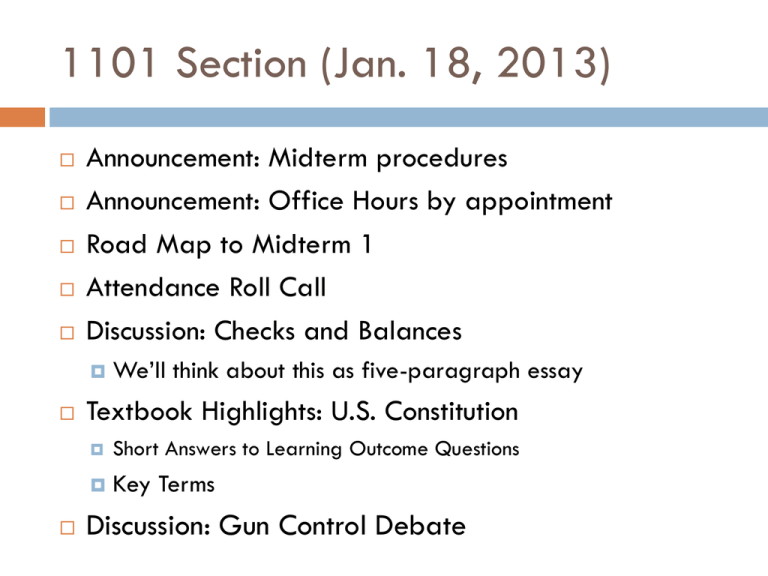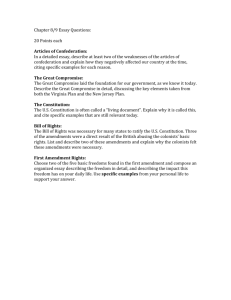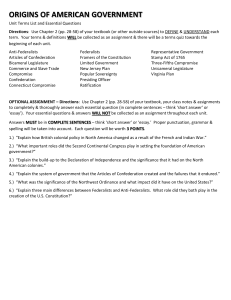Public Opinion and Mass Media
advertisement

1101 Section (Jan. 18, 2013) Announcement: Midterm procedures Announcement: Office Hours by appointment Road Map to Midterm 1 Attendance Roll Call Discussion: Checks and Balances We’ll think about this as five-paragraph essay Textbook Highlights: U.S. Constitution Short Answers to Learning Outcome Questions Key Terms Discussion: Gun Control Debate Essay Writing Practice Please review the memo I emailed on the form of five-paragraph essay Following this template: Allows you to organize your thoughts quickly and use your time wisely during tests Helps grader award you points! Gives you a better idea how to prepare for essay tests NEVER JUST START WRITING WHATEVER COMES INTO YOUR HEAD ON AN ESSAY EXAM Essay Writing Practice “Please explain the rational for checks and balances, and identify specific examples of checks and balances in the U.S. Constitution.” What’s the most logical outline for a fiveparagraph essay that answers this prompt? Let’s try this on the board… Consider the grader’s perspective: what’s the difference between B and C answers? A and B answers? Chapter Two Learning Outcomes L01: Explain the theoretical and historical factors that influenced the writers of the U.S. Constitution. Note: Constitution is capitalized, constitutional is not. Must address both theoretical (philosophical) and historical factors in your answer. Chapter Two Learning Outcomes L02: Describe the structure of the Articles of Confederation, and explain why the confederation failed. Chapter Two Learning Outcomes L03: Identify and explain the compromises made by the delegates to come to agreement on the U.S. Constitution. Chapter Two Learning Outcomes L04: Explain the rationale for, and give example of the separation of powers and the checks and balances in the U.S. Constitution. This is too broad for short answer question, but makes an excellent essay question. Chapter Two Learning Outcomes L05: Demonstrate understanding of the formal and informal processes for amending the U.S. Constitution. Chapter Two Key Terms Study tips: When it comes to historical events, you want to be able to answer the classic journalist-type questions about the event: Who? What? Why? Where? When? So What? You will not be tested on historical trivia. Pay attention to Gurian’s emphasis, repetition of phrases. Some Key Terms: Confederation v. Federal System NJ Plan v. VA Plan Great Compromise (CT Compromise) 3/5th Compromise Chapter Two Key Terms More Key Terms: Federalists v. Anti-Federalists Separation of Powers Checks and Balances Electoral College (Gurian studies pres. Elections) Supremacy Doctrine (distinguish judicial review) Express v. Implied Powers Necessary and Proper Clause (“Elastic Clause”) Gun Control Debate What is being proposed? What’s public opinion on issue? How well are leaders responding to public opinion? What’s boundary between states’ rights and federal supremacy?




